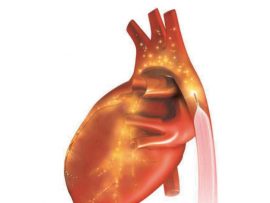Abstract Extracorporeal CO2 removal is a highly promising support therapy for patients with hypercapnic respiratory failure but whose clinical implementation and patient benefit is hampered by high cost and highly specialized..
Read MoreAbstract A Caucasian male with known severe aortic stenosis was referred to our Ophthalmology Department after undergoing cardiac surgery using extracorporeal circulation. Signs of retinal ischaemia were found during fundus..
Read MoreAbstract Introduction: Pediatric cardiac Extracorporeal Membrane Oxygenation (ECMO) is effective, however, bleeding and clotting issues continue to cause significant morbidity and mortality. The objective of this study was to assess..
Read MoreAbstract This practical guidance, endorsed by the Brazilian Society of Thrombosis and Hemostasis and The Brazilian Society of Angiology and Vascular Surgery, the International Union of Angiology and the European..
Read MoreAbstract Weaning failure and mortality rates in veno-arterial extracorporeal membrane oxygenation (VA-ECMO) supported patients are significant. Small studies suggest the possible usefulness of levosimendan in this environment, especially in postcardiotomy..
Read MoreTraditionally, ABO-incompatible heart transplantation was accomplished using a plasma exchange technique to remove recipient plasma containing donor-incompatible anti-A/B isohaemagglutinins. However, this technique exposed patients to large volumes of allogeneic blood..
Read MoreLos catéteres más pequeños son mejores para el paciente, ya que reducen las posibles complicaciones vasculares. Sensation 7 Fr. es el catéter BIA más pequeño disponible en la actualidad. Gracias..
Read MoreAbstract In cardiac surgical patients, tranexamic acid (TXA) has been associated with an increased risk of convulsive seizure (CS). We aimed to investigate whether in patients undergoing isolated coronary artery..
Read MoreAbstract Extracorporeal membrane oxygenation (ECMO) is inevitable external life support in case of cardiac and respiratory failure since the 1970s. Acute kidney injury (AKI) and the requirement of renal replacement..
Read MoreAbstract A morbidly obese middle aged woman in her 40's presented to another hospital with and subsequently developed severe . Her oxygenation demonstrated no improvement with low ventilation, paralysis, or prostagladin therapy. She..
Read MoreAbstract Lung transplantation may be a final destination therapy in lung failure, but limited donor organ availability creates a need for alternative management, including artificial lung technology. This invited review..
Read MoreAbstract During cardiopulmonary bypass (CPB), platelet activation and dysfunction are associated with adverse outcomes. Remote ischemic preconditioning (RIPC) has been shown to attenuate platelet activation. We evaluated the effects of..
Read MoreImpact of Corticosteroids on Cardiopulmonary Bypass Induced Inflammation in Children:A Meta-Analysis
Abstract Background Corticosteroids (CS) suppress the inflammatory response to cardiopulmonary bypass in children undergoing cardiac surgery. What is less clear is the impact of CS on the postoperative course. Methods..
Read MoreBackground It is unclear whether high-dose regimens of tranexamic acid in cardiac surgery (total dose, 80 to 100 mg/kg) confer a clinical advantage over low-dose regimens (total dose, approximately 20..
Read MoreIn 2002, Cribier et al. reported the first percutaneous transcatheter aortic valve replacement (TAVR) in a human subject. In this landmark manuscript, the authors described each step of the procedure..
Read MoreBackground Although corticosteroid prophylaxis in adult cardiac surgery has been studied extensively for 40 years, its role remains controversial, and the optimal dose remains uncertain. The objective of this meta-analysis..
Read MoreAbstract Platelet Mapping can measure both the degree of platelet inhibition and fibrinogen activation, was not originally designed to measure fibrinogen concentration. Traditional laboratory fibrinogen concentration testing requires around 60..
Read MoreAbstract Since the beginning of the pandemic Coronavirus Disease 2019 (COVID-19), calls were made for informed allocation of costly, limited health care resources such as extracorporeal membrane oxygenation (ECMO). At..
Read MoreThis 2020 International Consensus on Cardiopulmonary Resuscitation (CPR) and Emergency Cardiovascular Care Science With Treatment Recommendations on basic life support summarizes evidence evaluations performed for 20 topics that were prioritized..
Read MoreAbstract Cardioprotection encompasses a variety of strategies protecting the heart against myocardial injury that occurs during and after inadequate blood supply to the heart during myocardial infarction. While restoring reperfusion..
Read MoreObjective To review current literature evidence on outcomes of cardiac surgery in Jehovah’s Witness patients. Methods A comprehensive electronic literature search was done from 2010 to 20th August 2020 identifying..
Read MoreAbstract Extracorporeal life support (ECLS) can result in complications due to increased left ventricular (LV) afterload. The percutaneous ventricular assist device (PVAD) and intra-aortic balloon pump (IABP) are both considered..
Read MoreIntroduction In our institute, we began using peripheral veno-arterial (VA) extracorporeal membrane oxygenation (ECMO) in 2010, and peripheral veno-venous (VV) ECMO in 2015. This study aimed to describe clinical characteristics..
Read MoreIntroduction This study aimed to test a computer-driven cardiovascular model for the evaluation of the visceral flow during intra-aortic balloon pump (IABP) assistance. Methods The model includes a systemic and..
Read MoreAbstract Different arterial cannulation strategies are feasible for veno-arterial extracorporeal membrane oxygenation (VA-ECMO) in postcardiotomy shock. We aimed to analyze potential benefits and safety of different arterial cannulation strategies. We..
Read MoreAbstract Recirculation in venovenous extracorporeal membrane oxygenation (VV ECMO) leads to reduction in gas transfer efficiency. Studies of the factors contributing have been performed using in vivo studies and computational..
Read MoreAbstract Background Despite evidence suggesting detrimental effects of perioperative hyperoxia, hyperoxygenation remains commonplace in cardiac surgery. Hyperoxygenation may increase oxidative damage and neuronal injury leading to potential differences in postoperative..
Read MoreAbstract Objective To compare the hemodynamic effect of room temperature (cold) 4% albumin fluid bolus therapy (FBT) with body temperature (warm) albumin FBT. Design Prospective, before-after trial. Setting A tertiary..
Read MoreAbstract Objective To explore special coagulation characteristics and anticoagulation management in extracorporeal membrane oxygenation (ECMO)–assisted patients with coronavirus disease 2019 (COVID-19). Design Single-center, retrospective observation of a series of patients...
Read MoreAbstract Background A high hematocrit level in patients with erythrocytosis is linked with increased blood viscosity and increased risk of thromboembolism. Therefore, it is necessary to adequately lower the hematocrit..
Read More
















